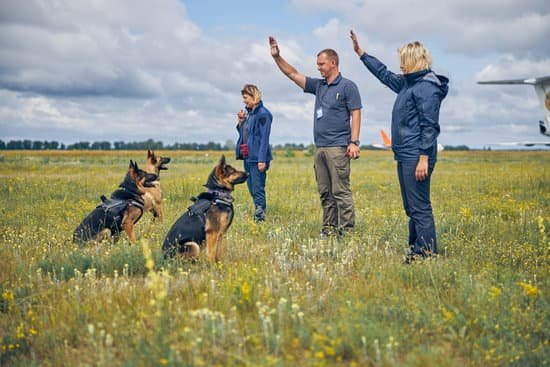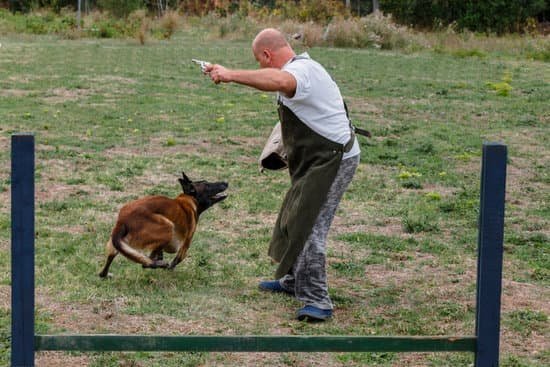Are you tired of constantly worrying about your furry friend running away every time you step outside? In this article, we will explore how to train your dog to not run away. Understanding the importance of this training is crucial for a pet owner, as it ensures the safety and well-being of your beloved canine companion.
There are various reasons why a dog may run away, from simple curiosity to anxiety or fear-based behaviors. By assessing these reasons and implementing proper training techniques, you can prevent your dog from engaging in this risky behavior.
Basic obedience training serves as the foundation for preventing a dog from running away. This includes teaching commands such as “sit,” “stay,” and “come” which are essential for controlling your dog’s movements and behavior. Additionally, establishing boundaries and barriers in the home and yard can help create a safe environment for your dog where they are less likely to run away. Stay tuned as we dive deeper into these topics later in the article.
Assessing the Reasons Why a Dog May Run Away
There are various reasons why a dog may exhibit behavior that includes running away. One of the most common causes is that the dog is not getting enough exercise or mental stimulation, leading them to seek out other sources of entertainment. Dogs are naturally curious animals and may be tempted to explore their surroundings if they are not engaged in other activities.
Another reason for running away behavior could be due to fear or anxiety. Loud noises, unfamiliar environments, or traumatic experiences can trigger these responses in dogs, causing them to bolt and try to escape from the situation. Understanding the triggers for your dog’s fear or anxiety can help you address and manage their behaviors more effectively.
Additionally, dogs that have not been properly socialized with people, other animals, or new environments may feel overwhelmed or threatened when faced with unfamiliar situations. This lack of socialization can lead to a dog trying to flee from what they perceive as a dangerous or uncomfortable situation.
Finally, intact male dogs are more likely to run away in search of a mate during breeding season. This natural instinct often leads them to roam over long distances in an attempt to find a female in heat. Spaying and neutering your dog can significantly reduce this behavior.
| Reasons for Running Away | Preventive Measures |
|---|---|
| Lack of exercise and mental stimulation | Provide regular walks, playtime, and training sessions |
| Fear and anxiety triggers | Desensitization training, calming aids like pheromone sprays or diffusers |
| Lack of socialization | Gradual exposure to different people, animals, and environments |
| Breeding instincts (intact male dogs), Spaying/neutering your pet can reduce roaming tendencies, |
Basic Obedience Training as a Foundation for Preventing a Dog From Running Away
Basic obedience training is essential in preventing a dog from running away. It provides the foundation for clear communication between you and your pet, and it establishes you as the leader of the pack. Teaching basic commands such as sit, stay, come, and heel can help you control your dog and keep them safe when they are off-leash. This type of training also builds trust and strengthens the bond between you and your furry friend.
One of the key aspects of basic obedience training is consistency. Dogs thrive on routine, so it’s important to practice training exercises regularly, preferably every day. Short, frequent training sessions are more effective than long, sporadic ones. By being consistent in your training efforts, you can instill good behavior in your dog and minimize the risk of them running away.
Another important component of basic obedience training is positive reinforcement. Using treats, praise, and affection to reward good behavior encourages your dog to repeat those behaviors.
Positive reinforcement creates a pleasant learning experience for your dog and helps them understand what is expected of them. When it comes to preventing running away behavior, positive reinforcement can be used to reinforce commands like “come” and “stay,” making it more likely that your dog will obey these cues when faced with potential escape situations.
| Aspect | Importance |
|---|---|
| Consistency | Establishes routine for the dog |
| Positive Reinforcement | Creates a pleasant learning experience for the dog |
| Obedience Commands | Helps control the dog off-leash |
Establishing Boundaries and Barriers in the Home and Yard
When it comes to training a dog to not run away, establishing boundaries and barriers in the home and yard is crucial. This helps prevent potential escape routes and keeps your dog safe within the designated areas. Here are some effective ways to achieve this:
1. Secure fencing: Ensure that your yard has a sturdy and secure fence that is high enough to prevent your dog from jumping over it. Regularly check for any holes or gaps that your dog could potentially squeeze through.
2. Use of pet gates: Inside the home, use pet gates to restrict access to certain areas where your dog may be tempted to run away from, such as the front door or areas with easy access to the outside.
3. Create a designated play area: Set up a specific area in your yard for your dog to play and exercise, equipped with toys, water, and shade. This designated space can help reduce the urge for your dog to wander off.
By implementing these boundaries and barriers in both the home and yard, you can significantly decrease the likelihood of your dog running away while providing a safe environment for them to thrive.
Using Positive Reinforcement and Rewards to Discourage Running Away Behavior
Positive reinforcement is a powerful tool when it comes to discouraging running away behavior in dogs. By rewarding your pet for staying close and obeying commands, you are effectively reinforcing the desired behavior. This can be done through verbal praise, treats, toys, or a combination of these rewards. It is important to make the reward immediately after the desired behavior is exhibited, so that the dog can associate the action with the positive outcome.
One effective method is to use treats during training sessions. Whenever your dog stays within boundaries or responds to recall commands, offer a treat as a reward. Over time, the dog will learn that sticking close and following commands results in a tasty incentive. However, it is important to gradually reduce the frequency of treats as the desired behavior becomes more consistent. This way, your pet will not become solely reliant on treats for good behavior.
In addition to treats, verbal praise and playtime can also serve as effective rewards. Dogs thrive on positive attention from their owners, and by using praise and affection as rewards for not running away, you are strengthening your bond with your pet while also promoting desirable behavior. Consistency and patience are key when using positive reinforcement; over time, your dog will learn that staying close and obeying commands results in favorable outcomes.
Training Techniques for Recall and Leash Manners
When it comes to preventing a dog from running away, training them in recall and leash manners is crucial. These techniques are essential for keeping your dog safe and under control, whether you’re out on a walk or enjoying time in the yard. Here are some effective training techniques to help improve recall and leash manners:
- Use high-value treats: When training your dog to come when called (recall), use high-value treats that your dog loves. This positive reinforcement will encourage them to respond to your command.
- Practice in a controlled environment: Start training in a quiet, distraction-free area before gradually progressing to more stimulating environments. This will help your dog stay focused on you when practicing recall.
- Utilize a long line: To work on leash manners, using a long line can give your dog some freedom while still allowing you to maintain control. This is especially helpful for training them to walk politely without pulling on the leash.
- Be patient and consistent: Training your dog for recall and leash manners takes time and consistency. Always use the same commands and techniques, and be patient with your furry friend as they learn.
By incorporating these techniques into your training regimen, you can minimize the risk of your dog running away and ensure that they stay safe and well-behaved during outdoor activities. Remember that consistent practice is key to success when it comes to training your dog in recall and leash manners.
Addressing Anxiety and Fear-Based Behaviors That May Lead to Running Away
Recognizing Signs of Anxiety and Fear
Dogs, like humans, can experience anxiety and fear which may lead to running away. It is important for dog owners to be aware of the signs that indicate their pet may be feeling anxious or fearful. Some common signs include panting, pacing, trembling, excessive barking, whining, hiding, and attempting to escape. Understanding these signals can help dog owners address the issue before it leads to their pet running away.
Creating a Safe Environment
One effective way to address anxiety and fear-based behaviors is by creating a safe and secure environment for the dog. This can include providing a comfortable space within the home where the dog feels protected and at ease.
Additionally, ensuring that the yard is properly fenced and secure can help prevent the dog from running away when feeling anxious or fearful. By eliminating potential triggers for anxiety and fear, owners can help their dogs feel more secure in their surroundings.
Seeking Professional Help
In some cases, addressing a dog’s anxiety and fear-based behaviors may require the assistance of a professional dog trainer or behaviorist. These experts can provide guidance on how to desensitize the dog to specific triggers, as well as techniques for building confidence and trust. Seeking professional help can be beneficial in addressing deep-rooted anxieties and fears that may lead to running away behavior in dogs.
Implementing Consistent Training and Reinforcement Strategies for Long-Term Success
Consistency Is Key
When it comes to training a dog to not run away, consistency is crucial for long-term success. This means that all members of the household should be on board with the training plan and consistently enforce the rules. Mixed messages can confuse a dog and hinder their progress. Consistency also applies to the use of commands, rewards, and consequences. By sticking to a consistent routine, your dog will better understand what is expected of them.
Regular Practice and Reinforcement
Just like any skill, training needs regular practice and reinforcement in order to stick. Set aside time each day for training exercises such as recall drills, leash manners practice, or obedience commands. Additionally, continue to use positive reinforcement and rewards as part of your ongoing training efforts. Even as your dog becomes more reliable in their behavior, it’s important to maintain consistent training to prevent any regression in their progress.
Seeking Professional Help if Needed
If you are struggling with implementing consistent training and reinforcement strategies for your dog, don’t hesitate to seek professional help. A reputable dog trainer can provide guidance on how to effectively maintain a consistent training plan tailored to your specific needs and challenges. They can offer valuable insight and techniques to help ensure long-term success in preventing your dog from running away.
By implementing these strategies for long-term success, you can enjoy the peace of mind that comes with having a well-trained, non-runaway dog as part of your family. Remember that patience and persistence are key when it comes to training a dog, so stay committed to the process for the best results.
Conclusion
In conclusion, training a dog to not run away is an essential aspect of responsible pet ownership. By understanding the reasons why a dog may run away and implementing basic obedience training, boundaries, and positive reinforcement techniques, owners can enjoy peace of mind knowing that their furry companion is safe and well-trained. Consistency in training and addressing any underlying anxiety or fear-based behaviors are crucial for long-term success in preventing a dog from running away.
Establishing boundaries and barriers in the home and yard, such as secure fencing and supervised outdoor time, can significantly reduce the risk of a dog escaping. Additionally, using positive reinforcement and rewards to encourage desirable behaviors while addressing recall and leash manners are effective techniques for preventing running away behavior. It’s important for dog owners to be patient and dedicated to the training process, as well as to seek professional help if needed.
Ultimately, the goal of training a dog to not run away is to create a strong bond between the owner and their pet based on trust and mutual respect. With consistent training and positive reinforcement, owners can enjoy the companionship of a well-trained, non-runaway dog while keeping them safe from potential dangers in their environment.
Frequently Asked Questions
How Do You Discipline a Dog That Keeps Running Away?
When disciplining a dog that keeps running away, it’s important to focus on positive reinforcement rather than punishment. First, ensure the dog’s basic needs are being met, such as regular exercise and mental stimulation.
Then, work on training commands like “come” and “stay” in a controlled environment. It’s also helpful to provide a safe and secure space for the dog at home to prevent them from running away in the first place.
How Do I Stop My Dog From Running Away When Called?
To stop a dog from running away when called, it’s essential to build trust and improve their recall response. This can be done by positively reinforcing the dog each time they come back when called.
Avoid scolding or punishing the dog when they return, as this may cause them to avoid coming back in the future. Additionally, using high-value treats and practicing recall exercises in different environments can help improve their response.
How Do You Train a Dog to Come When Called?
Training a dog to come when called involves patience, consistency, and positive reinforcement. Start by using a specific command such as “come” paired with a reward every time they respond correctly.
Gradually increase distance and distractions as the dog becomes more reliable in their response. It’s important to make coming when called a positive experience for the dog by using treats, praise, and playtime as rewards for their obedience.

Welcome to the blog! I am a professional dog trainer and have been working with dogs for many years. In this blog, I will be discussing various topics related to dog training, including tips, tricks, and advice. I hope you find this information helpful and informative. Thanks for reading!





